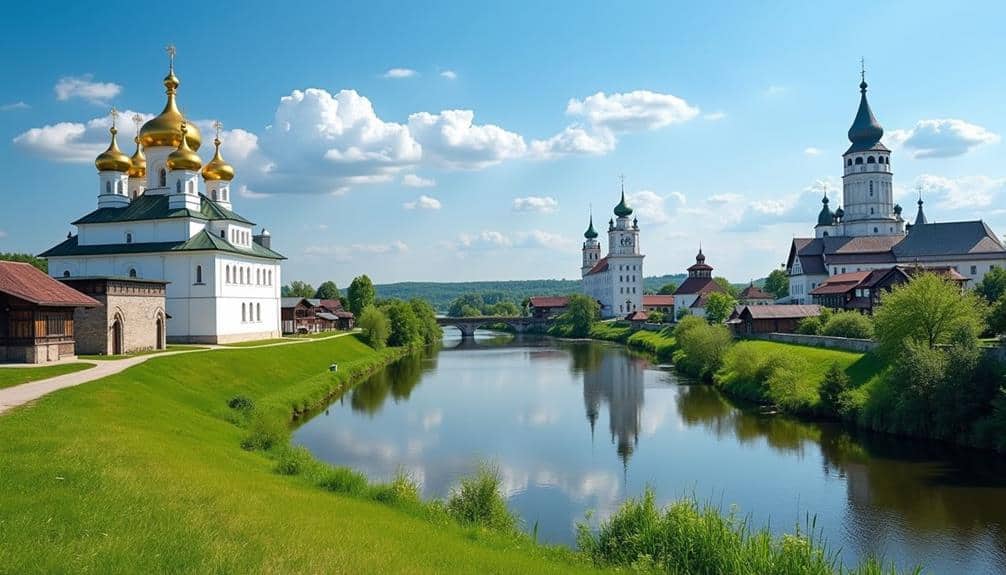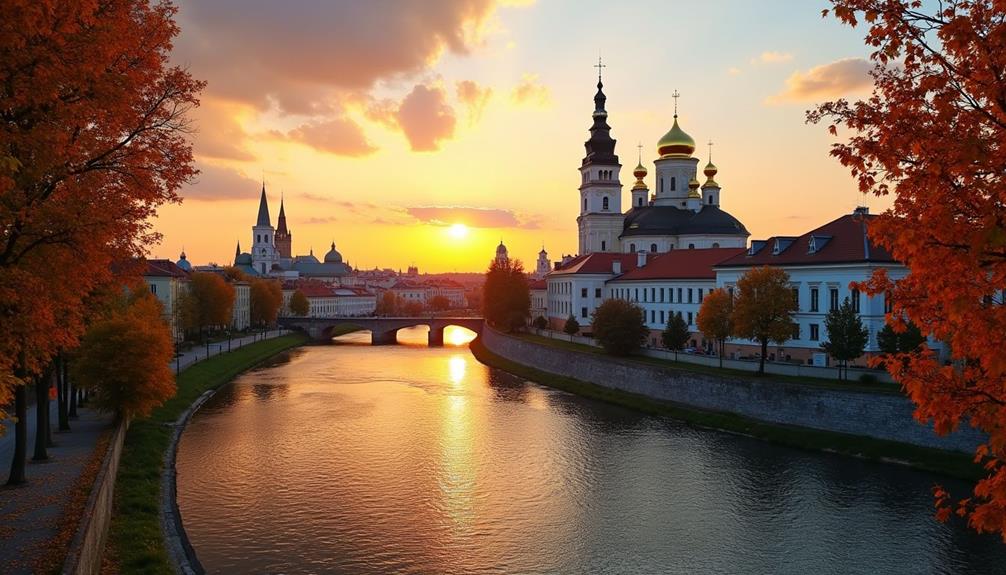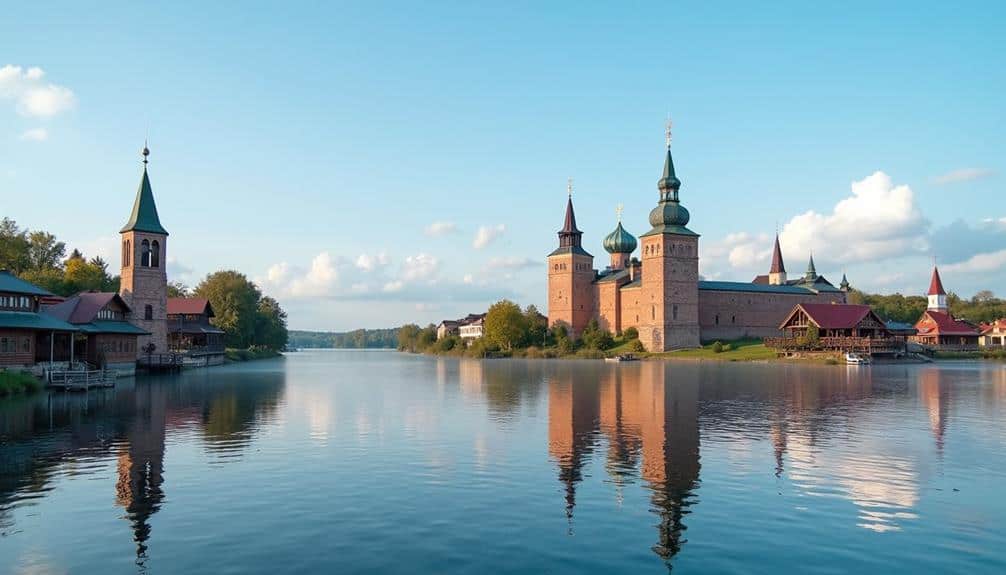Embarking on a journey through Russia’s Golden Ring cities is akin to unraveling the intricate threads that weave together the nation’s rich history and vibrant culture. Each destination along this captivating route serves as a distinct chapter, adding depth and color to the country’s captivating narrative. The medieval spires of Suzdal and the grandeur of Vladimir’s Cathedral of the Assumption serve as gateways to understanding Russia’s architectural evolution. Yaroslavl’s frescoed churches and Kostroma’s ties to the Romanov dynasty further enrich this odyssey. As one ventures into Rostov Veliky and Pereslavl-Zalessky, the blend of stunning architecture and regional gastronomy promises an exploration that is both enlightening and enthralling. What hidden gems await in these storied cities?
Suzdal

Suzdal, one of the most picturesque cities within Russia’s Golden Ring, is a living museum of Russian history and architecture. Renowned for its well-preserved medieval buildings, Suzdal architecture offers a striking glimpse into the past. The city is home to an array of stunning churches, monasteries, and wooden structures that date back to the 12th century.
The Cathedral of the Nativity, with its iconic blue domes adorned with golden stars, stands as a confirmation to the intricate craftsmanship of the era.
The charm of Suzdal extends beyond its buildings. Suzdal traditions play an essential role in preserving the unique cultural heritage of the region. Festivals such as the annual Cucumber Festival celebrate local customs and agricultural practices, bringing the community together in a vibrant display of folk music, dance, and cuisine.
Traditional crafts, including pottery and weaving, are still practiced and showcased at various local markets and workshops.
In Suzdal, the past and present coexist harmoniously, offering visitors an immersive experience into the heart of Russian culture. Its rich architectural legacy and enduring traditions make Suzdal a quintessential stop on a journey through Russia’s Golden Ring.
Vladimir
Among the cities that form Russia’s Golden Ring, Vladimir stands as a symbol to the country’s rich historical tapestry and architectural grandeur. Founded in 1108 by Prince Vladimir Monomakh, Vladimir played an essential role in the formation of the medieval Russian state. As a former capital of ancient Rus, the city boasts an illustrious history that is meticulously preserved in its many monuments and buildings.
The essence of Vladimir architecture is epitomized by the Cathedral of the Assumption, a masterpiece of white-stone construction dating back to the 12th century. This UNESCO World Heritage Site not only reflects the spiritual fervor of its time but also serves as an architectural blueprint for subsequent Russian churches.
Similarly, the Golden Gate of Vladimir, built in 1164, stands as an enduring symbol of medieval fortification and royal power.
In addition to its architectural marvels, Vladimir history is deeply intertwined with the cultural and political developments of early Russia. The city was a focal point for artistic and religious life, fostering a unique blend of Eastern Orthodox traditions and local craftsmanship.
Today, Vladimir remains a significant link in understanding the evolution of Russian cultural and architectural heritage.
Yaroslavl

Situated at the confluence of the Volga and Kotorosl rivers, Yaroslavl is another gem in Russia’s Golden Ring that offers a compelling glimpse into the nation’s storied past. Founded in the 11th century, the city boasts a rich tapestry of history, art, and spirituality.
Yaroslavl architecture is a symbol of its enduring legacy, with structures that span various periods of Russian history. One of the most iconic landmarks is the Church of Elijah the Prophet, renowned for its intricate frescoes and harmonious proportions. The Transfiguration Monastery, with its imposing walls and towers, further underscores the city’s architectural grandeur.
These edifices are not just religious sanctuaries but also serve as repositories of Yaroslavl culture, capturing the essence of its artistic and spiritual heritage.
Yaroslavl culture is vividly expressed through its museums, theaters, and festivals. The Yaroslavl Art Museum houses a remarkable collection of Russian fine art, while the Volkov Theater, Russia’s oldest, continues to stage classic and contemporary performances.
Annual events like the Yaroslavl Days of Jazz and the International Music Festival enliven the city, making it a vibrant cultural hub. Consequently, Yaroslavl stands as a beacon of historical and cultural richness within the Golden Ring.
Kostroma
Following the exploration of Yaroslavl, another cornerstone of Russia’s Golden Ring awaits in the form of Kostroma. This city, nestled along the banks of the Volga River, is a treasure trove of historical and architectural marvels.
Kostroma history dates back to its founding in the 12th century by Yuri Dolgoruky, making it one of the oldest towns in Russia. Throughout the centuries, Kostroma has played a pivotal role in Russian history, particularly during the Time of Troubles when the Romanov dynasty emerged from this very city.
Kostroma architecture is a reflection of its rich past, featuring an array of well-preserved structures from different eras. The Ipatiev Monastery, a focal point of Kostroma’s historical narrative, served as the cradle for the Romanov family’s rise to power.
Meanwhile, the city’s central square, known as Susaninskaya Square, is surrounded by remarkable neoclassical buildings, including the Fire Tower and the Trading Rows, reflecting the city’s economic significance during the 18th and 19th centuries.
For those seeking to understand the depth of Russian heritage, Kostroma offers an immersive experience through its historical sites and distinctive architectural styles, making it an indispensable part of the Golden Ring journey.
Rostov Veliky

Nestled on the shores of Lake Nero, Rostov Veliky is one of the most ancient and picturesque cities in Russia’s Golden Ring. Founded in 862, it is a city steeped in history, often referred to as Rostov the Great to distinguish it from Rostov-on-Don.
Rostov Veliky history is rich and multifaceted, with the city playing a significant role as a political and religious center in medieval Russia.
Rostov Veliky architecture is a reflection of its storied past, with the city’s landmarks showcasing a blend of traditional Russian styles. The Rostov Kremlin, also known as the Bishop’s Yard, stands as a magnificent example of 17th-century architecture. Its white stone walls, ornate towers, and golden domes create a stunning silhouette against the backdrop of Lake Nero.
Within the Kremlin, visitors can explore the Assumption Cathedral, which dates back to the 12th century and features beautiful frescoes and icons.
The city’s wooden houses, many of which are adorned with intricate carvings, offer a glimpse into traditional Russian craftsmanship.
Rostov Veliky’s historical and architectural heritage makes it an essential destination for anyone exploring Russia’s Golden Ring.
Pereslavl-Zalessky
Pereslavl-Zalessky, another gem in Russia’s Golden Ring, lies to the southeast of Rostov Veliky and continues the tradition of historical and cultural richness. Founded in 1152 by Prince Yuri Dolgoruky, this city boasts an array of historic landmarks that narrate the deep history of the region.
Among these, the Transfiguration Cathedral, the oldest surviving pre-Mongol structure north of Moscow, stands as a testament to the architectural prowess of the time. Another notable site is the Goritsky Monastery, which offers panoramic views of Lake Pleshcheyevo and a glimpse into monastic life.
The city’s charms extend beyond its historic landmarks to its delectable local cuisine. Visitors can savor traditional Russian dishes such as ukha (fish soup) made with the fresh catch from Lake Pleshcheyevo, and blini (pancakes) served with a variety of fillings.
The local eateries often feature recipes passed down through generations, providing an authentic culinary experience.
Pereslavl-Zalessky’s blend of history and gastronomy makes it a must-visit destination in the Golden Ring. Its serene landscapes and well-preserved heritage offer an enchanting journey into Russia’s storied past.




